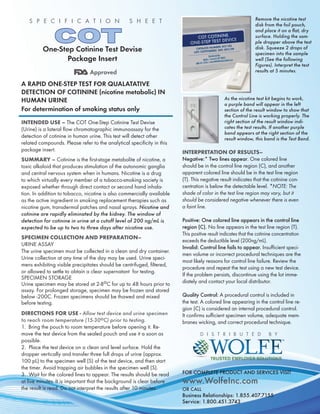
Cot
- 1. S P E C I F I C A T I O N S H E E T A RAPID ONE-STEP TEST FOR QUALATATIVE DETECTION OF COTININE (nicotine metabolic) in human urine For determination of smoking status only Intended Use – The COT One-Step Cotinine Test Devise (Urine) is a lateral flow chromatographic immunoassay for the detection of cotinine in human urine. This test will detect other related compounds. Please refer to the analytical specificity in this package insert. Summary – Cotinine is the first-stage metabolite of nicotine, a toxic alkaloid that produces stimulation of the autonomic ganglia and central nervous system when in humans. Nicotine is a drug to which virtually every member of a tobacco-smoking society is exposed whether through direct contact or second hand inhala- tion. In addition to tobacco, nicotine is also commercially available as the active ingredient in smoking replacement therapies such as nicotine gum, transdermal patches and nasal sprays. Nicotine and cotinine are rapidly eliminated by the kidney. The window of detection for cotinine in urine at a cutoff level of 200 ng/mL is expected to be up to two to three days after nicotine use. Specimen Collection and Preparation– URINE ASSAY The urine specimen must be collected in a clean and dry container. Urine collection at any time of the day may be used. Urine speci- mens exhibiting visible precipitates should be centrifuged, filtered, or allowed to settle to obtain a clear supernatant for testing. SPECIMEN STORAGE Urine specimen may be stored at 2-8oC for up to 48 hours prior to assay. For prolonged storage, specimen may be frozen and stored below -200C. Frozen specimens should be thawed and mixed before testing. Directions For Use - Allow test device and urine specimen to reach room temperature (15-30oC) prior to testing. 1. Bring the pouch to room temperature before opening it. Re- move the test device from the sealed pouch and use it a soon as possible. 2. Place the test device on a clean and level surface. Hold the dropper vertically and transfer three full drops of urine (approx. 100 pL) to the specimen well (S) of the test device, and then start the timer. Avoid trapping air bubbles in the specimen well (S). 3. Wait for the colored lines to appear. The results should be read at five minutes. It is important that the background is clear before the result is read. Do not interpret the results after 10 minutes. One-Step Cotinine Test Devise Package Insert COT Interpretation of results– Negative:* Two lines appear. One colored line should be in the control line region (C), and another apparent colored line should be in the test line region (T). This negative result indicates that the cotinine con- centration is below the detectable level. *NOTE: The shade of color in the test line region may vary, but it should be considered negative whenever there is even a faint line. Positive: One colored line appears in the control line region (C). No line appears in the test line region (T). This positive result indicates that the cotinine concentration exceeds the deductible level (200ng/mL). Invalid: Control line fails to appear. Insufficient speci- men volume or incorrect procedural techniques are the most likely reasons for control line failure. Review the procedure and repeat the test using a new test device. If the problem persists, discontinue using the lot imme- diately and contact your local distributor. Quality Control: A procedural control is included in the test. A colored line appearing in the control line re- gion (C) is considered an internal procedural control. It confirms sufficient specimen volume, adequate mem- branes wicking, and correct procedural technique. FOR COMPLETE PRODUCT AND SERVICES VISIT www.WolfeInc.com OR CALL Business Relationships: 1.855.407.7155 Service: 1.800.451.3743 Approved Remove the nicotine test disk from the foil pouch, and place it on a flat, dry surface. Holding the sam- ple dropper above the test disk. Squeeze 2 drops of specimen into the sample well (See the following Figures). Interpret the test results at 5 minutes. As the nicotine test kit begins to work, a purple band will appear in the left section of the result window to show that the Control Line is working properly. The right section of the result window indi- cates the test results. If another purple band appears at the right section of the result window, this band is the Test Band. D I S T R I B U T E D B Y